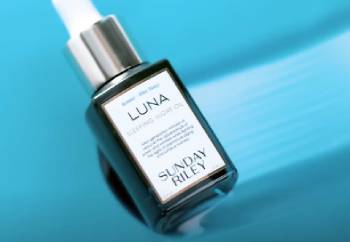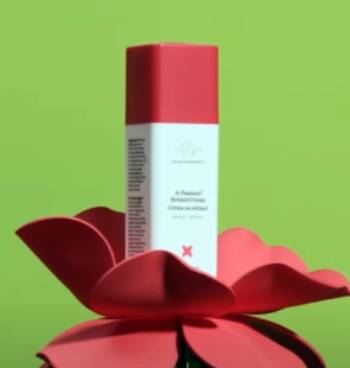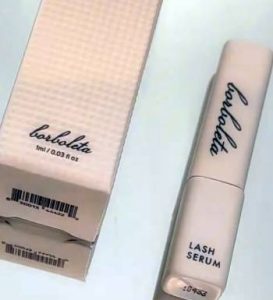Aging skin needs a hero, and Sunday Riley Luna Sleeping Night Oil is mine. This blue-hued, retinol-infused oil transforms skin overnight, tackling fine lines, redness, and pores while keeping sensitive skin happy. At 50, I’ve seen my complexion glow like never before. It’s a splurge, but a little goes a long way, making it worth every penny. If you want dewy, youthful skin without irritation, grab Luna now. Trust me, your face will thank you by morning—add it to your cart and see the magic happen.
My Journey with Sunday Riley Luna Sleeping Night Oil

At 50, my fair, sensitive skin and pustular rosacea made finding a nighttime product a nightmare. Retinol sounded scary—my skin gets mad at everything—but Luna’s gentle formula caught my eye. I read rave reviews and, despite the $105 price tag, decided to try the 0.5-ounce bottle. I started cautiously, applying three drops after my rosacea treatment (ivermectin, fully absorbed). The blue oil, scented with blue tansy, felt luxurious, not heavy. It soaked in fast, leaving no residue or teal tint, just a happy glow.
After a week, my skin was brighter, with smaller pores and softer fine lines around my eyes. By week four, my complexion was smoother, dewier, and—miraculously—no rosacea flare-ups. I layered moisturizer in winter, but Luna alone often sufficed. My neck and chest got some love, too, looking plumper. The cost stung, but the bottle lasted months since a little goes far. I slacked off once, and my skin dulled fast—Luna’s now non-negotiable. Pairing it with Thayer’s witch hazel mist and Good Genes boosted results, making my skin feel reborn every morning.
What Makes Luna Sleeping Night Oil Stand Out?
Luna is a next-generation retinol oil, using hydroxypinacolone retinoate, a gentler retinoid that fights wrinkles and pores without irritation. Blue tansy and chamomile soothe redness, while avocado, chia, and grape seed oils hydrate and plump.
A 2018 study on retinoids confirms their role in boosting collagen, which I saw in my skin’s firmness. The oil’s vegan, cruelty-free, and free of sulfates, parabens, and gluten. Apply two to three drops at night on clean skin; it shifts from blue to clear when massaged in. It’s not for pregnant folks due to retinol but suits sensitive, acne-prone, or rosacea-prone skin.
I love how Luna balances potency and gentleness. My rosacea stayed calm, unlike with harsher retinols. The oil’s anti-inflammatory botanicals, like azulene-rich blue tansy, kept redness at bay. It’s pricy, but the 4-week clinical proof of smoother, radiant skin matches my experience. If you’re new to retinol or have finicky skin, Luna’s a safe bet.
Maintenance Tips for Using Luna Sleeping Night Oil

- Apply to Clean, Dry Skin: Start with a gentle cleanser to prep your face. I use a micellar water, then pat dry. Apply two to three drops of Luna, massaging until the blue turns clear. Clean skin ensures maximum absorption, boosting results. Avoid damp skin—it dilutes the oil’s potency.
- Use Sparingly and Build Up: Less is more with Luna. I began with three drops twice weekly, increasing to three times after two weeks. Overusing can irritate, especially for retinol newbies. If you notice redness, scale back. A little goes far, so your bottle lasts longer.
- Layer Correctly with Other Products: Apply Luna after serums but before moisturizer. I wait five minutes post-Luna before adding Good Genes or a cream. If you’re using actives like AHAs, alternate nights to avoid irritation. My routine—Luna, then moisturizer—keeps my skin balanced and hydrated.
- Always Use Sunscreen Daily: Retinol makes skin sun-sensitive, so SPF is non-negotiable. I slather on SPF 30 every morning, even indoors. It protects my glow and prevents damage. Skip this, and you risk burns or dark spots, undoing Luna’s magic. Keep sunscreen handy year-round.
- Store Properly to Preserve Potency: Keep Luna in a cool, dark place, like a drawer. Heat or sunlight can degrade retinol, reducing effectiveness. I store mine away from my bathroom’s humidity. Check the expiration date—using old oil won’t deliver. Proper storage ensures every drop works hard.
Pros and Cons of Luna Sleeping Night Oil

Pros:
- Gentle Yet Effective Retinol: Luna’s hydroxypinacolone retinoate works wonders without the burn of traditional retinol. My sensitive, rosacea-prone skin stayed calm, with no peeling or redness. After four weeks, my fine lines softened, and my pores looked smaller. It’s perfect if you’re retinol-shy but want anti-aging perks.
- Calms Redness and Rosacea: The blue tansy and chamomile are game-changers. My rosacea flare-ups vanished, and redness faded noticeably. I felt confident skipping heavy concealer. If you deal with irritation or angry skin, Luna’s soothing botanicals make it a lifesaver, leaving you calm and even-toned.
- Hydrates and Plumps Skin: Avocado and chia seed oils give Luna a hydrating edge. My dry skin drank it up, looking plumper by morning. In warmer months, I skipped moisturizer—Luna was enough. It left my face, neck, and chest dewy, never greasy, with a glow that screamed healthy.
- Reduces Pores and Fine Lines: My nose pores used to be a magnifying glass’s dream. Luna shrank them visibly, and my forehead lines softened. After a month, my skin texture was smoother, like I’d hit refresh. If you’re battling visible pores or early wrinkles, this oil delivers real results.
- Long-Lasting and Economical: A 0.5-ounce bottle lasts months with just three drops per use. I used it three times weekly, and it stretched over six months. The high price feels less painful when you realize how little you need. It’s an investment that pays off in radiant skin.
Cons:
- High Price Tag: At $105 for 0.5 ounces, Luna’s a wallet-punch. I hesitated before buying, and if you’re on a budget, it’s tough to justify. Even though it lasts, the upfront cost stings. I wish Sunday Riley offered a smaller, cheaper starter size for newbies.
- Strong Herbal Scent: The blue tansy scent, while spa-like, is intense at first. My husband griped about it, though it fades in minutes. If you’re sensitive to fragrances, it might bug you. I grew to love it, but test a sample if scents are a dealbreaker.
- Artificial Blue Coloring: Luna’s blue hue, from added dyes (CI 61565, CI 60725), is gimmicky. It vanishes on skin, but I’d prefer no artificial colors. Some users worry about staining sheets, though I never had issues. Natural blue tansy alone would’ve been enough.
- Not Pregnancy-Safe: Retinol makes Luna off-limits during pregnancy. I’m past that stage, but if you’re expecting, you’ll need to skip it. It’s safe for breastfeeding with a doctor’s okay, but this limits its audience. Always check with a physician if unsure.
- May Cause Initial Breakouts: Though gentle, Luna can trigger purging in acne-prone skin. I was lucky, but friends reported small pimples when starting. It’s temporary as skin adjusts to retinol, but brace for a week or two of bumps if your skin’s oily or reactive.
Luna Sleeping Night Oil Vs. Other Night Oils
- Luna Sleeping Night Oil Vs. Kiehl’s Midnight Recovery Concentrate

Kiehl’s Midnight Recovery, with lavender and squalane, hydrates and calms. I used it for a month; it left my skin soft but didn’t shrink pores or tackle fine lines like Luna.
No retinol means it’s gentler but less anti-aging. At $54 for 1 ounce, it’s cheaper but lacks Luna’s transformative punch.
If you want moisture over actives, Kiehl’s is great; for retinol benefits, Luna wins.
- Luna Sleeping Night Oil Vs. Drunk Elephant A-Gloei Maretinol Oil

Drunk Elephant’s A-Gloei, with marula oil and retinol, targets texture and radiance. I tried it, and it brightened well but irritated my rosacea slightly.
Priced at $72 for 1 ounce, it’s more affordable than Luna. Its lighter texture suits oily skin, but Luna’s soothing botanicals were kinder to my sensitive face.
If you’re not rosacea-prone, Drunk Elephant’s a solid pick; I stick with Luna.
- Luna Sleeping Night Oil Vs. The Ordinary Retinol 0.5% in Squalane
The Ordinary’s retinol oil, at $8 for 1 ounce, is budget-friendly. I tested it, and it reduced fine lines but dried my skin, triggering redness. Luna’s blue tansy and oils kept my rosacea calm, which The Ordinary couldn’t. For newbies or non-sensitive skin, it’s a cheap intro to retinol; Luna’s my choice for comfort and results.
- Luna Sleeping Night Oil Vs. Herbivore Botanicals Lapis Blue Tansy Oil
Herbivore’s Lapis, with blue tansy and jojoba, soothes and hydrates. I used it for redness, and it calmed my skin but didn’t address pores or wrinkles. At $72 for 1.7 ounces, it’s comparable in price but lacks retinol. Herbivore’s great for sensitive, non-aging skin; Luna’s retinol edge makes it my go-to for anti-aging.
- Luna Sleeping Night Oil Vs. Biossance Squalane + Vitamin C Rose Oil
Biossance’s oil, with vitamin C and rose, brightens and hydrates. I tried it for a glow, and it delivered but didn’t firm like Luna. At $74 for 1 ounce, it’s slightly cheaper. No retinol means no irritation but less wrinkle-fighting power. Biossance suits brightening fans; Luna’s my pick for comprehensive anti-aging.
Frequently Asked Questions (FAQs)
Yes, you can, especially if your skin’s dry. I apply moisturizer after Luna in winter, waiting five minutes for absorption. Luna’s hydrating enough aloneκαλλιτεχνίδα, but for oily or normal skin, you might skip it. The oil isn’t occlusive, so layering a lightweight cream seals in benefits. Always use SPF daily with retinol.
Start with two to three nights weekly, using two to three drops. I began twice a week, then upped to three after two weeks. Sensitive skin needs a gradual intro to avoid irritation. Once tolerated, you can use it nightly if your skin’s happy.
Yes, it contains hydroxypinacolone retinoate, a gentle retinoid. It’s less irritating than traditional retinol, making it ideal for sensitive or rosacea-prone skin. It fights wrinkles, pores, and redness, delivering youthful skin with minimal side effects, as I’ve experienced.
Apply Luna after cleansing and serums, before moisturizer. I use it post-toner, massaging three drops until clear, then wait five minutes before Good Genes or cream. Alternate nights with actives like AHAs to prevent irritation. Always follow with SPF in the morning.
Final Thoughts
Luna Sleeping Night Oil is my skin’s savior, delivering glowy, youthful results without upsetting my rosacea. Its gentle retinol, soothing blue tansy, and hydrating oils shrink pores and soften lines in weeks. Yes, it’s pricey, and the scent’s strong, but the long-lasting bottle and radiant skin make it worth it. Grab Luna and pair it with a simple routine for a complexion that turns heads. You’ll wake up to smoother, dewier skin—trust me, this oil’s magic is real, and your face deserves it.



